Case Report: Emergence of Candida auris in the Indian Ocean Region
- PMID: 33319729
- PMCID: PMC7866352
- DOI: 10.4269/ajtmh.20-0758
Case Report: Emergence of Candida auris in the Indian Ocean Region
Abstract
Candida auris is an emerging multidrug-resistant yeast that can cause severe infections and spread easily between hospitalized patients, leading to outbreaks in hospital. Here, we report the first four cases of colonization and invasive infection with C. auris reported in the Indian Ocean region. All cases were observed in the French overseas Reunion Island, a very popular destination for European travelers. Three patients had urinary tract or skin colonization, and one had a fatal invasive infection. In three cases, including that of the infected patient, the yeast was not initially identified as C. auris, preventing specific hygiene measures to be implemented as suggested in the December 2016 clinical alert to European healthcare facilities. The infected patient likely acquired C. auris in the intensive care unit from the first colonized patient. This is the first case of C. auris infection and the first potential case of nosocomial transmission of the pathogen to be reported in the French overseas Reunion Island.
Figures


References
-
- Chowdhary A, et al. 2014. Multidrug-resistant endemic clonal strain of Candida auris in India. Eur J Clin Microbiol Infect Dis 33: 919–926. - PubMed
-
- CDC , 2019. General Information about Candida auris | Candida auris | Fungal Diseases. Available at: https://www.cdc.gov/fungal/candida-auris/candida-auris-qanda.html. Accessed November 19, 2019.
Publication types
MeSH terms
Substances
Supplementary concepts
LinkOut - more resources
Full Text Sources
Other Literature Sources
Medical

